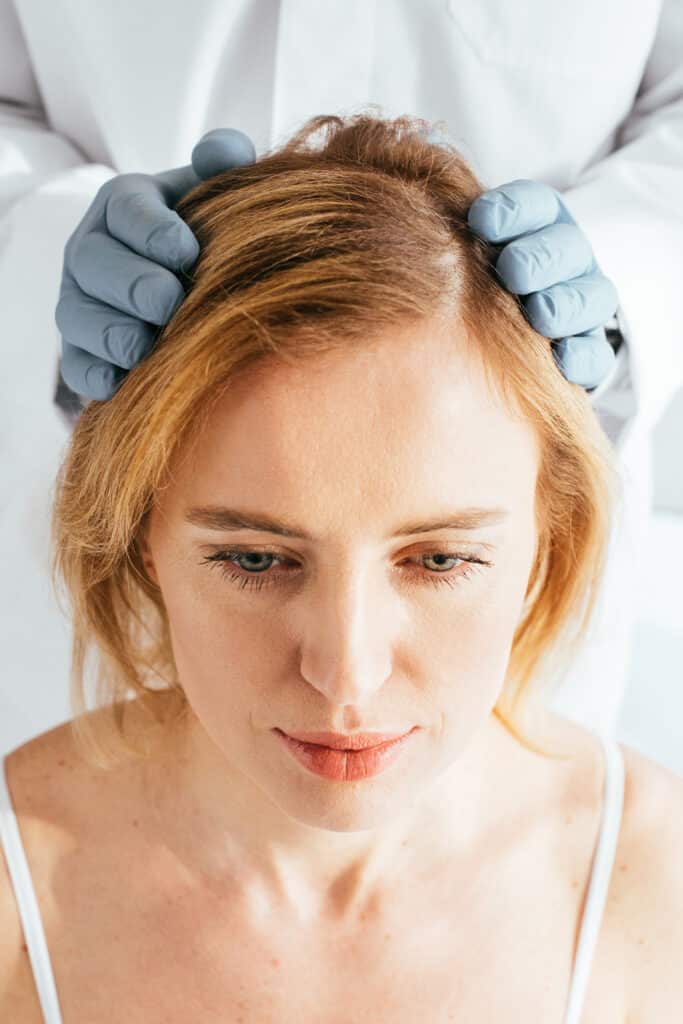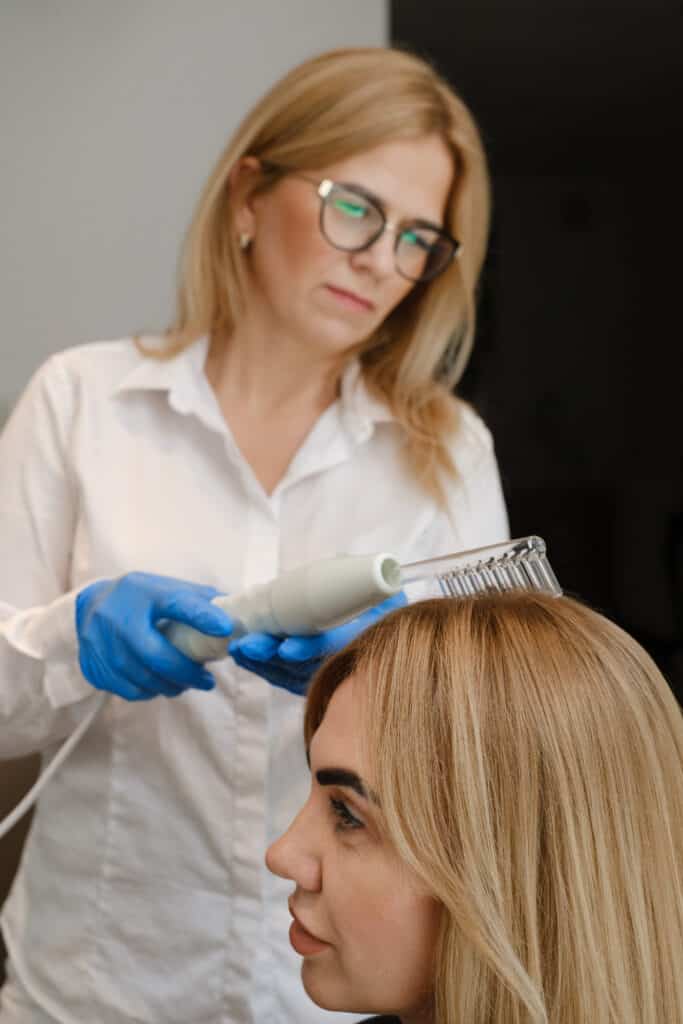Top Strategies for Effective Beautiful Hair Replacement for Women
Imagine a world where hair loss no longer dictates self-confidence and style choices. With the proper knowledge and hair replacement solutions, overcoming hair loss can be a reality. In this blog post, you’ll learn about various hair replacement options, including enhancing natural growing hair for women, the factors to consider when choosing a solution, and how to maintain the results for a confident, beautiful you.
KEY TAKEAWAYS
- Understanding female hair loss is essential to identify the root cause and how to treat it.
- Various non-surgical and surgical treatments, such as topical treatments, hair enhancements, toppers, and FUE & FTI hair surgeries, are available.
- How to locate/identify a specialist for an informed treatment decision that suits individual needs & maintain results with proper care & follow-up appointments.
UNDERSTANDING FEMALE HAIR LOSS

Female hair loss is a common concern that affects millions of women worldwide. Understanding the root causes allows you to take steps to address the problem and restore your hair. Genetic predisposition, hormonal changes, and medical conditions, such as thyroid disorders and iron deficiency, can trigger hair loss in women. Identifying the type and cause of your hair loss aids in selecting the most effective treatment.
Some typical signs of female hair loss include a widened part, diminished ponytail, or sudden and gradual noticeable hair loss affecting the scalp or the entire body. Thinning hair and a receding hairline can also be a concern for some women. Fortunately, various treatments are available to address hair loss in women, including options to treat female pattern thinning, which helps prevent further hair loss. Your choices can range from over-the-counter topical therapies to prescription medications, and in-office procedures with a trained hair loss specialist can be the best place to begin.
Types of Hair Loss in Women
There are three primary types of hair loss in women:
- Androgenetic alopecia, also known as female pattern hair loss or female pattern baldness, occurs when hair follicles miniaturize, leading to thinner, shorter, and less dense hair. This type of hair loss is caused by the action of hormones called androgens, which play an essential role in both male and female sexual development and hair growth regulation. Male pattern baldness and male pattern hair loss can also be seen in women, isolated to the temples and top of the head. Treatments for androgenetic alopecia aim to stimulate hair growth by counteracting the effects of androgens.
- Telogen effluvium is a temporary hair loss condition that occurs when numerous hair follicles simultaneously move into the shedding stage of their growth cycle. This can be triggered by stress, illness, hormonal changes, or certain medications. The hair usually regrows once the underlying cause is addressed.
- Alopecia areata is an autoimmune disorder where the body’s immune system incorrectly targets and attacks the hair follicles, causing hair loss. This type of hair loss can occur in patchy balding areas on the scalp, eyebrows, or body. Treatment options for alopecia areata include topical medications, injections, and immunotherapy.
In contrast, telogen effluvium is characterized by aggressive acute hair loss due to stress or physical trauma, while alopecia areata is an autoimmune disorder that results in patchy hair loss. Understanding the type of hair loss you’re experiencing is the first step toward finding the most effective treatment for your unique situation.
Common Triggers for Hair Loss
Apart from genetics and hormonal changes, several common triggers can cause or exacerbate hair loss in women. These triggers include:
- Stress
- Certain medications
- Preexisting health conditions such as thyroid disease, anemia, and autoimmune disorders, vitamin and mineral deficiencies.
- Continuous physical stress on the hair, such as traction from tight hairstyles or intentional pulling, can lead to hair loss. This type of hair loss is often seen in conditions like traction alopecia, where sustained tension on the scalp damages hair follicles.
Identifying and addressing these triggers allows you to proactively manage and possibly change the outcome of your hair loss.
Consulting with a Trichologist and healthcare professional can offer a better understanding of the underlying causes of your hair loss and guide you to suitable options for treatment.
SURGICAL HAIR RESTORATION TECHNIQUES

If you are seeking a more lasting solution to hair loss, you may consider surgical hair restoration techniques such as follicular unit transplantation (FUT) and follicular unit extraction (FUE) as a hair loss treatment. These procedures involve the transplantation of hair follicles from a donor area not affected by genetic hair loss, offering long-lasting results.
While surgical hair restoration techniques come with higher initial costs, they can provide a more permanent solution for those seeking to regain a fuller head of hair. Consulting with a qualified hair restoration specialist to discuss the most suitable surgical option for your individual needs and circumstances is necessary.
Follicular Unit Transplantation (FUT)
Follicular unit transplantation (FUT) is a widely used technique in hair transplant surgery, accounting for 90% of all procedures. The FUT process involves:
- Removing a strip of skin from the scalp, typically from the back of the head
- Dividing the strip into individual follicular units containing one to four hairs
FUT has a high success rate, with an estimated 90% to 95% of transplanted hair grafts growing successfully. However, note that the procedure does leave a linear scar that might be visible though faded. Consultation with a hair transplant surgeon can help determine if FUT is the right option for you.
Follicular Unit Extraction (FUE)
Follicular Unit Extraction (FUE) is a less invasive hair restoration procedure where individual hair follicles are carefully extracted from the donor region, typically the back or sides of the head. These follicles are then transplanted to the area where hair growth is desired. Unlike FUT, FUE does not involve removing a strip of scalp, which results in virtually no scarring and a faster recovery time.
The estimated recovery time for an FUE procedure is typically around 7-10 days, with minimal scarring at the back of the head. Although FUE may be a more expensive option than FUT, it offers a more natural appearance with less visible scarring, making it an attractive option for those seeking a permanent hair restoration solution.
NON-SURGICAL HAIR ENHANCEMENT OPTIONS

Several non-surgical hair enhancement options can provide a viable solution for those who prefer a non-invasive approach to hair restoration. These options encompass topical treatments, hair growth supplements, hair enhancing additions, or hair pieces. Each of these options comes with its unique set of advantages, and the choice ultimately depends on your individual needs, preferences, and budget.
Non-surgical hair replacement or hair enhancement options are great for those seeking less invasive and more cost-effective alternatives to surgical procedures. Although these options might not offer the same permanence as surgical treatments, they can provide a remarkable physical enhancement to your appearance, self-esteem, and overall sense of self!
Topical Treatments
- Minoxidil (Rogaine): This medication is primarily used for treating androgenetic alopecia, also known as genetic hair loss. Minoxidil works by dilating blood vessels around the hair follicles, which may improve hair follicle function and stimulate hair growth. It’s available over the counter and is applied directly to the scalp.
- Ketoconazole (Nizoral): Unlike minoxidil, ketoconazole is often used for conditions like alopecia areata, an autoimmune form of hair loss. It has antifungal properties and can reduce inflammation, which may be beneficial in promoting hair growth in certain types of alopecia. Ketoconazole is typically found in medicated shampoos and is available over the counter and by prescription.
Always seek guidance from a healthcare professional before starting a new treatment regimen.
Hair Growth Supplements

Hair growth supplements can provide essential nutrients to support healthy hair growth. Some popular supplements include:
- Viviscal
- Sugarbear Hair
- Olly Ultra-Strength Hair Softgels
- Nutrafol
- Biotin
- Replenology Natural
- Hair, skin and nails vitamins
However, it’s important to remember that individual results may vary, and excessive intake of certain supplements could have adverse effects. Take caution; “hair vitamins” can be good or BAD. You must determine if you have a deficiency and what vitamins or minerals are needed.
By taking a personalized approach to hair growth supplements, you can help ensure positive results while minimizing potential risks.
Toppers and Hair Enhancements
Hair enhancements/toppers and prosthetics offer a solution for hair loss and can be designed and customized to match your natural hair. Hair enhancements are available in the highest quality European hair, various styles, and materials, allowing you to customize and design hair enhancements.
Adding a hair enhancement to your growing hair can boost your confidence and self-esteem!
CHOOSING THE RIGHT HAIR ENHANCEMENT SOLUTION
Selecting the right hair enhancement solution is a personal decision, depending on several factors, including the cause of hair loss, budget, and desired results. Consulting with a hair loss specialist can provide valuable guidance in determining the most appropriate solution for your needs. With a wide range of treatment options, finding the right hair enhancement solution is possible for everyone.
However, remember that no single solution is perfect for everyone. Your circumstances, preferences, and goals will play a significant role in determining the most suitable hair enhancement option for you. By carefully considering these factors and consulting with a specialist, you can make a well-informed decision that best addresses your hair loss concerns.
Consultation with a Specialist
Consulting with a hair loss specialist or a trichologist can assist you in navigating the complex options of hair replacement and making the most suitable choice based on your individual needs. A hair loss specialist will evaluate your hair loss condition, discuss your goals and expectations, and recommend the most suitable hair replacement system for you.
During a hair loss consultation, the specialist may:
- Perform a thorough examination of your scalp and hair
- Take photographs for documentation
- Discuss potential treatment options
- Develop a personalized treatment plan
By seeking the guidance of a specialist, you can ensure that you’re making the best decision for your hair restoration journey.
Factors to Consider
When choosing a hair replacement solution, considering factors such as the severity of hair loss, personal preferences, and potential side effects is essential. The severity of hair loss can significantly impact the treatment choice, as different solutions may be more suitable for varying levels of hair loss severity.
Personal preferences also play a crucial role in selecting a hair replacement solution. The ideal solution should accommodate your desired look, comfort, and convenience. Budget and affordability can also be deciding factors, as different options have varying costs.
Considering all these factors can help you decide to address your concerns best when you start to lose hair and face hair loss issues.
MAINTAINING HAIR EHANCMENT RESULTS
The results of your hair enhancement treatment require ongoing care and attention for maintenance. Proper hair care can help prolong the results of hair enhancement treatments. Additionally, follow-up treatments may be necessary to maintain the desired results, especially for non-surgical hair replacement options.
Adhering to post-treatment care instructions and maintaining a healthy hair care routine can maximize the effectiveness of your chosen hair replacement solution, leading to long-lasting results. Restoring your hair and confidence is possible with the proper treatment, care, and commitment.
Proper Hair Care
Proper hair care is necessary to maintain the results of hair replacement treatments. After a hair replacement procedure, it is recommended to wait a minimum of 48 hours before washing your hair. Use lukewarm water and a mild, sulfate-free shampoo, followed by a conditioner designed for post-hair replacement care.
Gently pat the hair dry with a soft towel and style as desired, avoiding any harsh handling of the hair. Be sure to follow any specific instructions given by our specialist to ensure the best results and minimize potential complications.
SUMMARY
In conclusion, hair replacement options for women are diverse and cater to a variety of preferences, budgets, and hair loss severity levels. From non-surgical options like topical treatments, hair growth supplements, and hairpieces to more permanent surgical solutions such as FUT and FUE, there is a solution for everyone. By understanding the underlying causes of hair loss, consulting with a specialist, and carefully considering personal preferences and circumstances, you can successfully restore your hair and regain your confidence.
FREQUENTLY ASKED QUESTIONS
Does hair replacement work for women?
Yes, hair replacement and hair enhancements can work for women, especially those suffering from androgenic alopecia, traction alopecia, trauma, accidents, medically related hair loss (chemotherapy or radiation therapy treatments), or plastic surgery patients.
How much are hair transplants for women?
The average hair transplant cost in the United States is approximately $7,425, but this can range from $4,000 to $15,000. The total cost varies depending on the number of hair grafts needed to achieve the desired result. Factors influencing the price include the extent of hair loss, the type of hair transplant technique used, and the patient’s specific requirements. For a more detailed breakdown and understanding of these costs, you can refer to the provided CareCredit link here.
What are some common causes of hair loss in women?
Common causes of hair loss in women include genetic predisposition (female pattern hair loss), hormonal changes (such as those during pregnancy, menopause, or due to thyroid disorders), stress (which can lead to temporary hair loss), certain medications (including those for cancer, arthritis, and heart problems), and underlying health conditions like autoimmune diseases, iron deficiency anemia, and polycystic ovary syndrome (PCOS). Each factor contributes uniquely to hair loss and varies in impact among individuals.
Seeking Hair Restoration Services in Nashville?
For those in Nashville seeking assistance with hair restoration, HPIHair comes highly recommended. Known for their proficiency in addressing a variety of hair loss conditions, they provide a selection of effective treatments personalized to meet individual requirements.
What is the difference between androgenetic alopecia and telogen effluvium?
Androgenetic alopecia, commonly known as male or female pattern baldness, is a hereditary form of hair loss that results in gradual thinning, often seen as a receding hairline or thinning across the scalp. Its causes are believed to be a combination of genetic and hormonal factors. In contrast, telogen effluvium is a temporary condition characterized by rapid hair shedding, typically occurring a few months after a significant stressor or bodily change such as severe stress, illness, or hormonal changes. Unlike androgenetic alopecia, telogen effluvium usually results in hair regrowth once the underlying cause is addressed.








